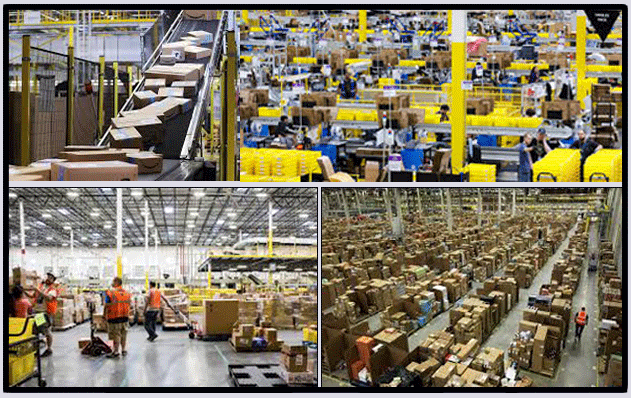|
Watching the previews for the Frontline show titled “Amazon Empire: The Rise & Reign of Jeff Bezos” reminded me of the Mel Brooks movie History Of The World; in
it, the monarchy blithely ignores the needs of its citizens.
“The people are revolting,”
Count de Money tells Brooks, who plays the King.
“You're telling me—they stink
on ice!” the King replies.
Largest Job Creator In USA
In “Amazon Empire,” ex-Amazon workers bemoaned their former treatment with sentiments like:
“At Amazon, you’re just disposable.”
It’s a level of dissonance that might
not work well for a company out to take over the retail and shipping worlds.
Frontline depicts Amazon today
as the largest job creator in the USA.
“At fulfillment centers Amazon has
experimented with new techniques and technologies to increase productivity,” Frontline reported.
“When a company perfected a warehouse
robot, Amazon bought the whole company,” Frontline continued.
Robots Transform The Warehouse
“[Robots] helped transform the work
environment at Amazon," said an Amazon spokesperson.
“We added 200,000 robots and at the
same time since 2012, we have added 300,000 people in our fulfillment
centers,” Amazon said.
“The robots changed the work so people
don’t have to walk, they make the job safer and more accurate.
“That’s all good for both customers
and employees," Amazon added.
But Frontline claimed that at the
same time, employee complaints have persisted.

A Whole New Ballgame
Sheheryar Kaoosji, who serves as Executive
Director of Warehouse Workers Resource Center (WWRC) and is an advocate
for factory workers, says, “at Amazon, it’s a whole new ballgame
for warehouse workers.
“Because of the way that Amazon operates,
and the manner in which they set goals for productivity, the work is harder
physically and also psychologically.”
WWRC has been advising some 15,000 Amazon
employees at ten fulfillment centers in the San Bernadino, California,
area of their rights. Frontline sat down and talked to ex-Amazon
warehouse fulfillment employees and the results were eye-raising.
“It was exciting for me,” said
one ex-employee.
“I thought I would set some roots
in the company, a good job moving up.
“But after being at Amazon, it was
like, no way!”
Another ex-employee said, “At first
I thought, that this is a place I can make a career, but after working
at Amazon for a time, I decided that it was not realistic the way they
expect you to work.”
Frontline reported that the story
was much the same with the dozens of workers they spoke to all over the
United States. The workers said “[they] were struggling with the
pace Amazon expected them to pick and pack items.”
Having Trouble Keeping The Rate
“You simply can’t keep up with
demand,” was the recurring comment.
“A rate of pick and pack is set,”
said an ex-employee.
“You reach that rate and rather than
maintaining that level, Amazon pushes up the rate demand,” the former
worker told Frontline.
“You have security cameras all the
time looking at you 24/7 so if you don’t meet standards you are
out the door, you’re just disposable,” another worker said.
Watching & Working The Beat
Goes On
“Every worker,” an ex-employee
said, “has a scanner at all times that basically tracks where you
are at and they have a little blue at the bottom of the screen and it
has like how many seconds you have to have it done by the time it hits
zero and it puts you into panic mode and you just constantly have to hit
this scanner like a robot all day long.
“If they catch you not scanning, you
get a write up.
“What they are doing is producing
this mass of data that they are using to be able to analyze their entire
work force.”
Workers Swimming In A Data Stream
 “We
are not treated as human beings,” an ex-employee declared, “we
are not even treated as robots; we are treated as part of the data stream.” “We
are not treated as human beings,” an ex-employee declared, “we
are not even treated as robots; we are treated as part of the data stream.”
Frontline mused that it’s
the incentive at any assembly line to get the most out of workers to make
rates and be as efficient and as productive as possible—so what’s
the difference between Amazon and any other warehouse?
“Amazon is the cutting edge,”
says Sheheryar Kaoosji.
“Other warehouses are starting to
adopt these technologies.
“Other companies are definitely interested
in what Amazon is doing.
“Data collection could become basically
the standard for all workers, and that means that as a worker you are
never good enough, you are never able to keep up,” added Kaoosji.
The Amazon Answers
Amazon told Frontline that work
rates are not based on an individual employee’s performance and
that the scanning devices that workers use are for tracking inventory,
not people, and are common practice in the warehouse industry.
Amazon reportedly has over 600,000 employees
nationwide, but the company did not tell Frontline how long average
warehouse workers stay with the company or supply accident rate statistics
for warehouse worker injuries on the job.
Frontline noted that to date Amazon
has resisted unionization.
Amazon reponded, saying, “it is not
anti-union; it just feels that the things the union would want us to do
we have already done.”
Amazon noted that it pays double the national
minimum wage and that workers have great benefits.
As to employees being treated like robots,
Amazon said that was news to them and that “this kind of work is
not for everyone.”
Amazon pointed out that the company has
become a leader in training people for career advancement, having recently
created a seven hundred million dollar program to advance people at the
company.
Some Safety Concerns
“What they don’t talk about
are the safety rules that you have to ignore, to make rates,” an
ex-employee said.
“It’s not that you just go in
and do your job and that’s it.
“So you’re in a weird bind;
it’s incredibly hard to meet rates while following all the safety
procedures.”
Asked about those comments, Amazon told Frontline that if employees tell the company something is not
working, they will fix it.
The Frontline Amazon episode is
scheduled for broadcast on Public Broadcast Stations, February 18 at 9:00
pm ET in the U.S. Our worldwide readers can access it here.
Geoffrey
|




